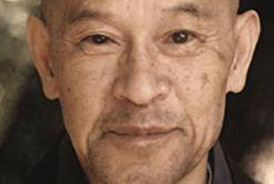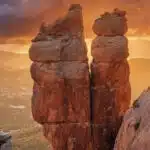by Shunryu Suzuki: This lecture is reprinted from the June 2002 Berkeley Zen Center Newsletter.
True concentration does not mean to be concentrated on only one thing. Although we say, “Do things one by one,” what we mean is difficult to explain. Without trying to concentrate our mind on anything, we are ready to concentrate on something. For instance, if my eyes are on one person in the zendo, it will be impossible to give my attention to others. So when I pactice zazen, I’m not watching anybody. Then if someone moves, I can see them.
Avalokiteshvara is the Bodhisattva of Compassion. Originally portrayed as a man, Avalokiteshvara also appears in the form of a woman. Sometimes she has one thousand hands to help others, but if she concentrates on only one hand, the nine hundred and ninety nine hands will be of no use.
From ancient times the main point of practice has been to have a clear, calm mind, whatever you do. Even when you eat something good, your mind should be clear enough to appreciate the labor of preparing the food and the effort of making the dishes, chopsticks, bowls, and everything we use. With a serene mind we can appreciate the flavor of each vegetable, one by one. We don’t add much seasoning, so we can enjoy the virtue of each vegetable. That is how we cook and how we eat food.
To know someone is to sense that person’s flavor, what you feel from someone. Each person has his or her own flavor, a particular personality from which many feelings appear. To fully appreciate this personality or flavor is to have a good relationship. Then we can really be friendly. To be friendly does not mean to cling to someone or to try to please them, but to have a full appreciation of them.
To appreciate things and people, our minds should be calm and clear. So we practice zazen or “just sitting” without a gaining idea. At this time you are you yourself. You settle yourself on yourself. With this practice we have freedom, but it may be that the freedom you mean and the freedom a Zen Buddhist means are not the same. To attain freedom we cross our legs, keep our posture upright, and let our eyes and ears be open to everything. This readiness or openness is important because by nature we are often apt to go to extremes. We stick to things and lose our calmness or mirror-like mind.
Zazen practice is how we obtain this calmness and clarity of mind, but we cannot do this by physically forcing something on ourselves or by creating some special state of mind. You may think to have a mirror-like mind is Zen practice. It is so, but if you practice zazen in order to attain that kind of mirror-like mind, that is not the practice we mean. It has become, instead, the “art of Zen.”
The difference between the art of Zen and true Zen is that already you have true Zen without trying. Because you try to do something, you lose it. You are concentrating on one hand out of one thousand hands. You lose nine hundred and ninety nine hands. That is why we say “just sit.” It does not mean to stop your mind altogether or to be concentrated completely on your breathing, although these are a kind of help.
When you count your breath, you don’t think much and you have no gaining idea. You may become bored, because counting the breath does not mean much to you, but then you have lost your understanding of real practice. We practice concentration or let our mind follow our breathing so that we are not involved in some complicated practice in which we lose ourselves attempting to accomplish something.
In the art of Zen, you try to be like a skillful Zen master who has great strength and good practice. You say, “Oh, I want to be like him. I must try hard.” When you do this, you are learning the art of Zen, not practicing true Zen.
The art of Zen is concerned with how to draw a straight line or how to control your mind. But Zen is for everyone, even if you cannot draw a straight line. If you can draw a line, just draw a line, that is Zen. For a child this is natural, and even though the line is not straight, it is beautiful. So whether or not you like the cross-legged position, or whether or not you think you can do it, if you know what zazen really is, you can do it.
The most important thing in our practice is just to follow our schedule and to do things with people. You may say this is group practice, but it is not. Group practice is quite different, another kind of art. In wartime, some young people, encouraged by the militaristic mood of Japan, recited to me this line from the Shushogi: “To understand birth and death is the main point of practice.” They said, “Even though I don’t know anything about the sutra, I can die easily at the front.” That is group practice. Encouraged by trumpets, guns, and war cries, it is quite easy to die.
That kind of practice is not our practice either. Although first of all, we practice with people, our goal is to practice with mountains and rivers, with trees and stones, with everything in the world, everything in the universe, and to find ourselves in this big cosmos. When we practice in this big world we know intuitively which way to go. When your surroundings give you a sign showing which way to go, even though you have no idea of following a sign, you will go in the right direction. The way to practice with everything is to have calmness of mind.
To practice our way is good, but you may be practicing with a mistaken idea. Still if you know, “I am making a mistake, but even so I cannot help continuing practice,” then there is no need to worry. If you open your true eyes and accept the you that is involved in a wrong idea of practice, that is real practice.
You can accept your thinking because it is already there. You cannot do anything about it. There is no need to get rid of it. This is not a matter of right and wrong, but how to accept frankly, with openness of mind, what you are doing. That is the most important point. When you practice zazen you will accept the you who is thinking about something, without trying to be free of the images you have. “Oh! Here they come.” If someone is moving over there, “Oh, he is moving.” And if he stops moving, your eyes remain the same. That is how your eyes will see when you are not watching anything special. In that way your practice includes everything, one thing after another, and you do not lose your calmness of mind.
The extent of this practice is limitless. With this as our base, we have real freedom. When you evaluate your self as being good or bad, right or wrong, black or white, that is comparative value, and you lose your absolute value. When you evaluate yourself by a limitless measure, each one of you will be settled on your real self. That is enough, even though you think you need a better way to measure. If you understand this point, you will know what real practice is for human beings and for everything.
















































